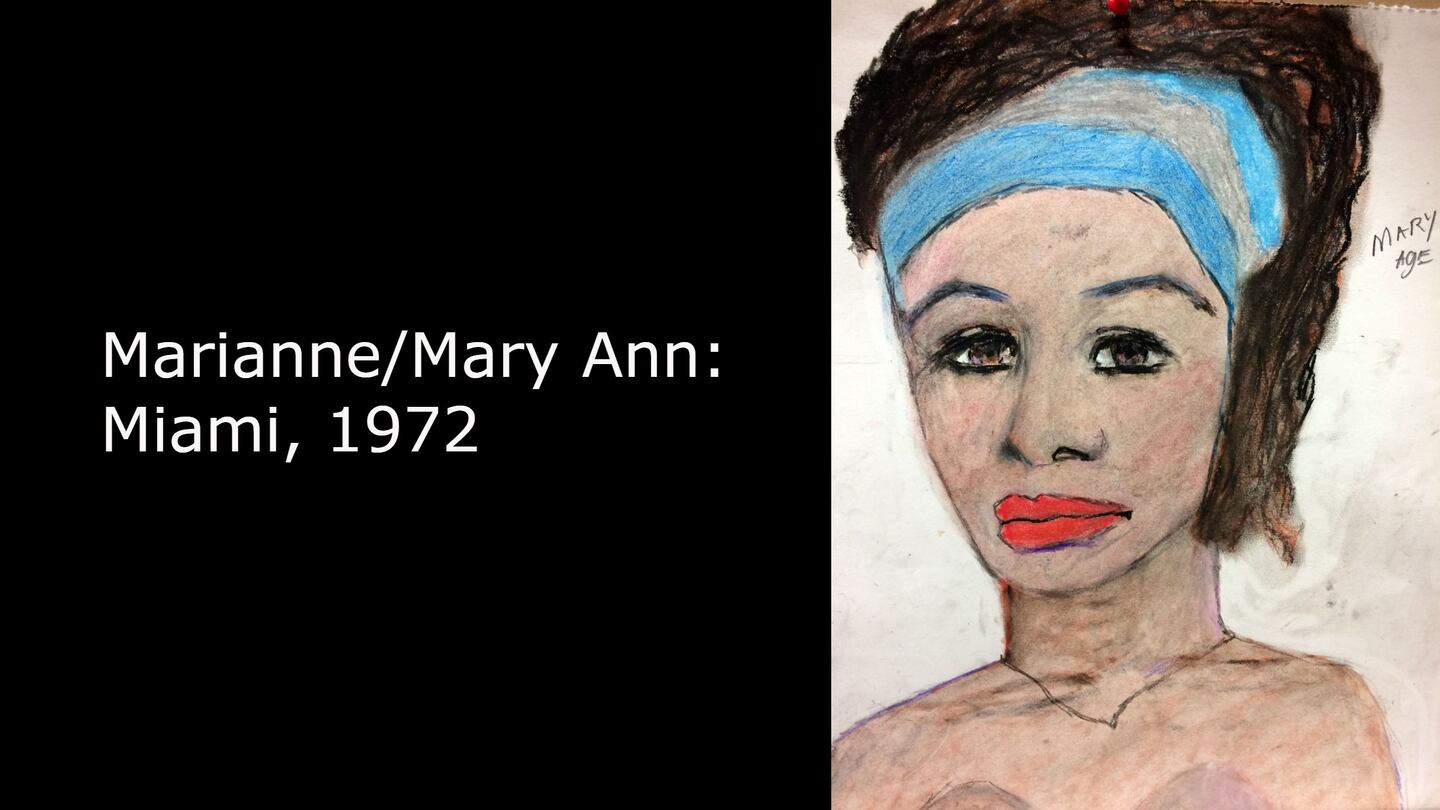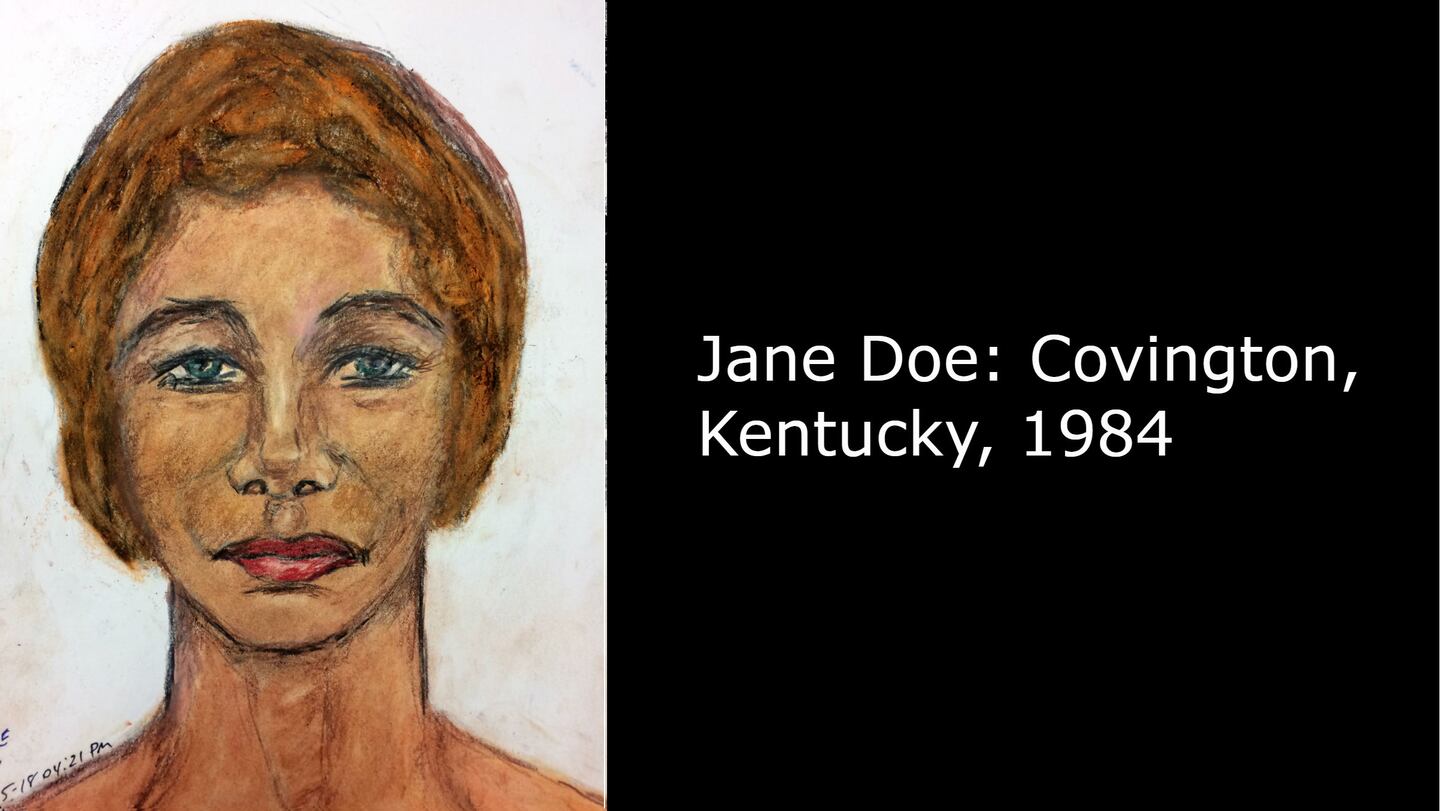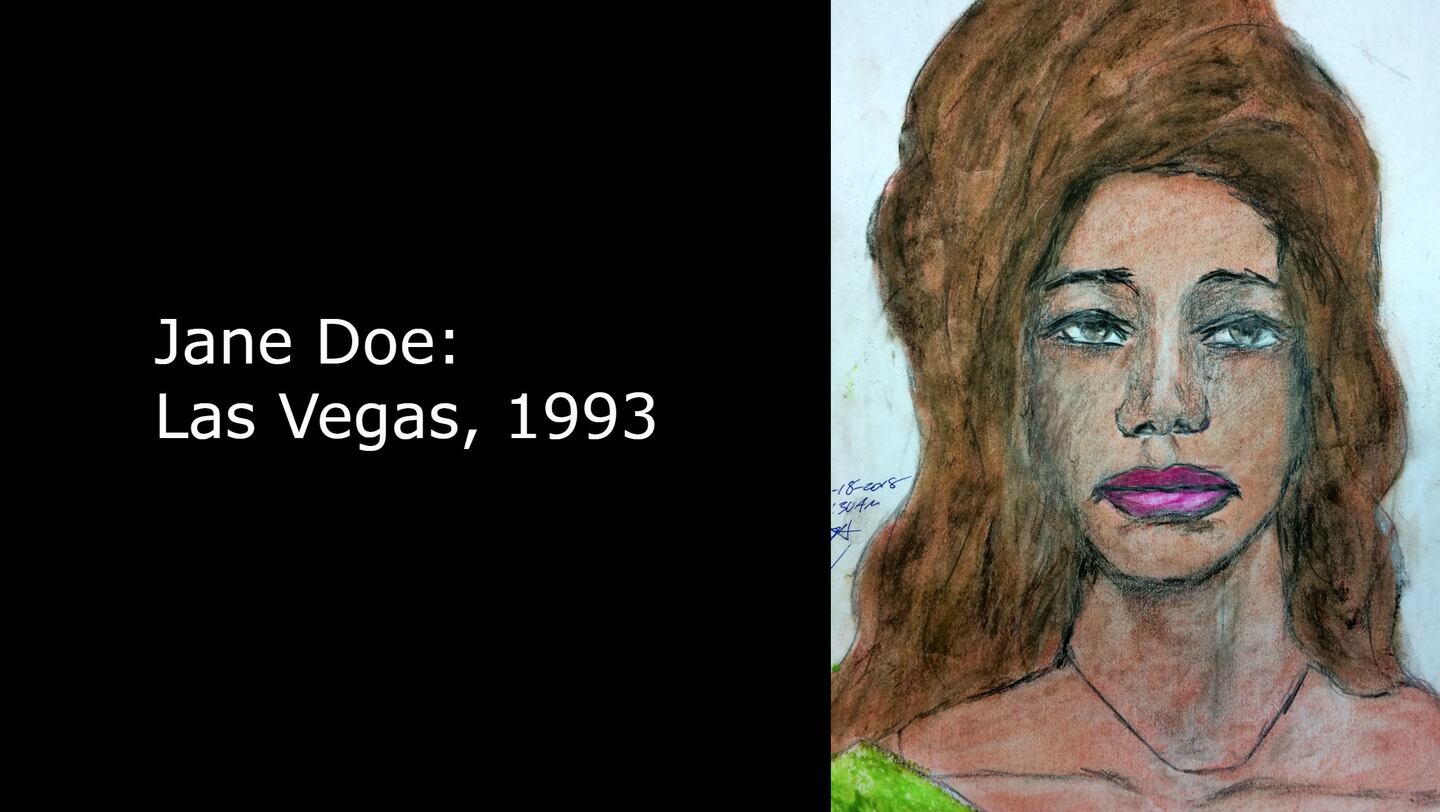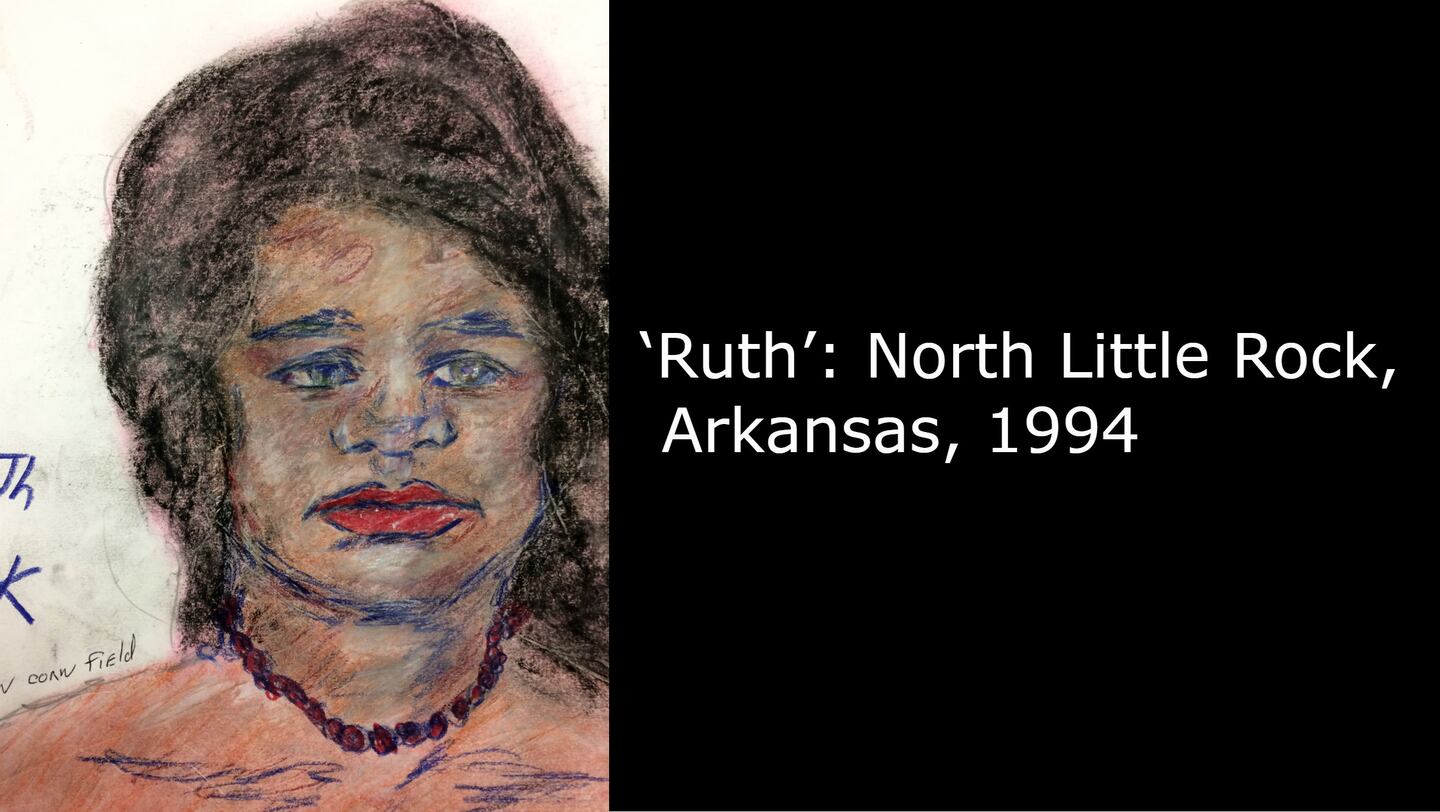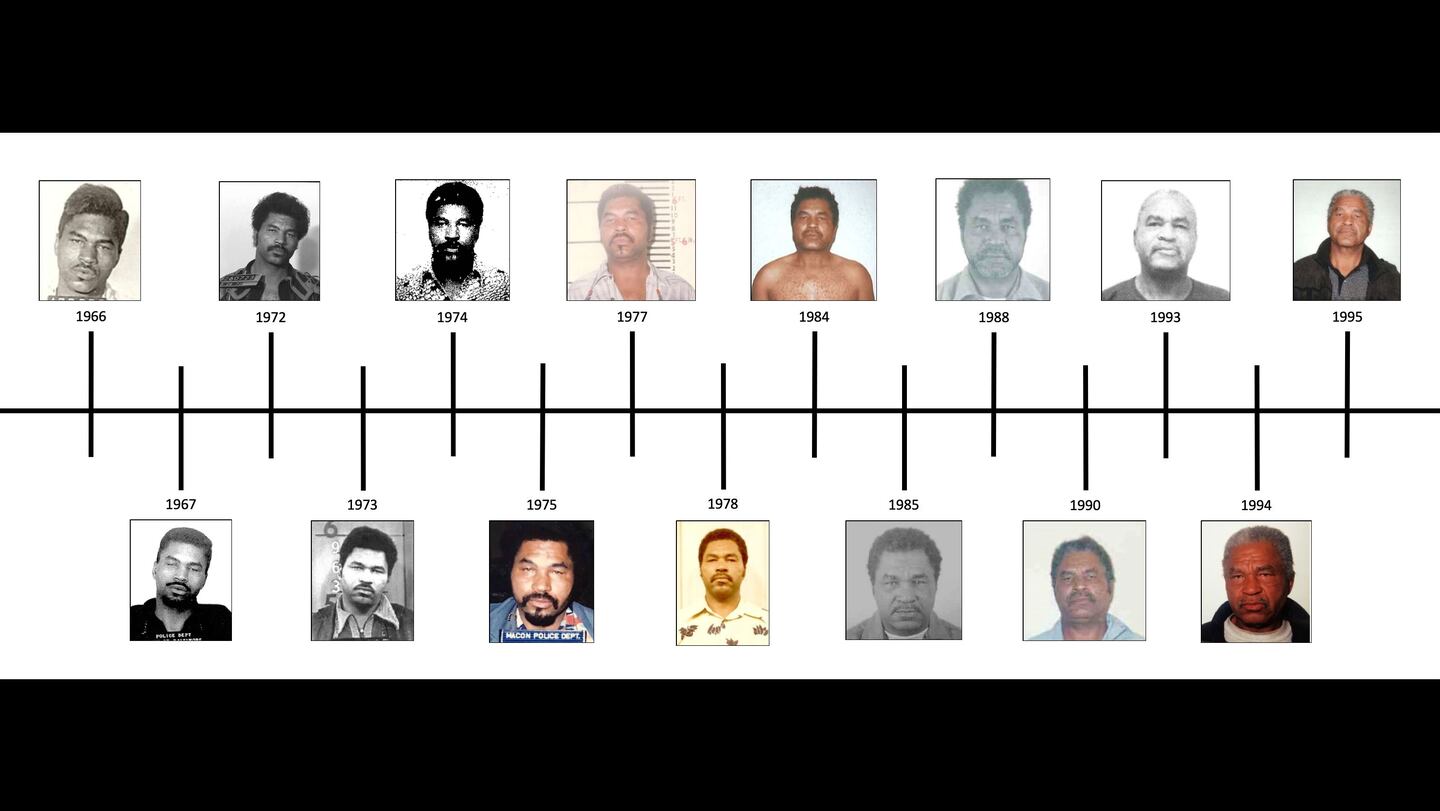FBI agents are calling Samuel Little the most prolific serial killer in American history, but many of Little’s victims remain unidentified, their faces known only through crude colored sketches drawn for authorities by their killer.
Little, 79, has confessed to murdering 93 women between 1970 and 2005. Little, a high school dropout who has lived a mostly nomadic life, is currently serving life sentences in the California State Prison for three of those killings.
He is diabetic, has heart disease and relies on a wheelchair to get around, The New York Times reported. Besides the three murders he is serving time for in California, Little also pleaded guilty last year to one murder in Texas and, in August, pleaded guilty to four more in Ohio.
The FBI on Sunday announced that agents have thus far been able to link Little to 50 of the slayings he has confessed to and said the bureau's crime analysts believe all 93 of his confessions are credible. The findings mean that Little is believed to be responsible for more killings than Gary Ridgway, who, labeled the "Green River Killer," was convicted in 2003 of 49 murders in Washington State in the 1980s and 1990s.
Authorities in Knox County, Tennessee, said Monday that a woman named Martha Cunningham, who was found dead in a wooded area in 1975, is likely a victim of Little, The Associated Press reported. Investigators in countless other jurisdictions are also combing their files to determine if any of their cold cases fit Little's confessions.
Federal investigators are meanwhile seeking the public’s help in identifying five women Little said he killed, but who have remained unaccounted for.
One of those cases is more than 45 years old.
>> Related story: This Georgia-born serial killer is now the deadliest in US history, FBI says
Federal authorities said Little targeted women who lived on the outskirts of society, some of them prostitutes and drug users.
“Little’s method of killing also didn’t always leave obvious signs that the death was a homicide,” an FBI statement said. “The one-time competitive boxer usually stunned or knocked out his victims with powerful punches and then strangled them.”
Investigators said the beatings prior to the women's deaths were so brutal that one victim's autopsy showed she was struck in the abdomen with such force that it broke her spine, according to The New York Times.
The bodies were often found long after the signs of strangulation would have been gone, sometimes when the remains were nothing but bones.
“With no stab marks or bullet wounds, many of these deaths were not classified as homicides, but attributed to drug overdoses, accidents or natural causes,” authorities said.
As part of their efforts, FBI officials have taken the unusual step of posting online Little’s confessions in those homicides, along with the sketches Little drew of the women based on his own recollections.
The information comes with a couple of caveats: Little’s details may be off a little -- and the killer’s confessions are chilling.
"Samuel Little's recollection of dates is not always accurate," FBI agents said in a statement. "He also sometimes struggles to remember the exact clothing worn by a victim. Any potential links should not be dismissed based on these two factors alone.
“The videos of Little contain references to violent acts. Viewer discretion is encouraged.”
Little told authorities he first met Marianne, an 18- or 19-year-old transgender woman, at a bar known as the Pool or the Pool Palace in Miami around 1972. They encountered one another a few days later at another bar in Overtown, where Little said he offered to give Marianne a ride home.
Marianne, who Little said had a boyfriend named Wes, lived with roommates somewhere between Brownsville and Liberty City, according to his confession.
"When they arrived there, one of Marianne's roommates asked them to buy a can of shaving cream, so they returned to Little's car, a gold four-door Pontiac LeMans," the FBI page on the case states.
In his confession, Little told agents he was driving his “stepdaddy’s” car at that time.
"Little drove Marianne north on Highway 27 and killed her on a driveway, possibly near a sugarcane field," FBI officials said.
In his confession, Little stated that he was headed toward Fort Lauderdale when he noticed a road off of the main road, about a mile or two out of Miami.
"So, I got her out of the car," Little told Texas Ranger James Holland, who is credited with eliciting the majority of Little's confessions. "Pulled her out and drug her into the growth back there. And pulled her deeper into ... there's a path, a little path that went in somewhere. I don't know where it led to, but it running deeper into the undergrowth.
“It’s like Everglades like that, and we ran into some water running. And but before we got to the water, the earth was mushy. I turn her loose and she fell into it face down.”
Little told agents he doesn’t believe Marianne, who he dumped about 200 yards into the “thick, muddy water,” was ever found, agents said.
The killer described Marianne as good-looking, about 140 pounds and about 5 feet, 6 inches or 5 feet, 7 inches tall.
Little told investigators he met a black woman with “honey-colored” skin in New Orleans in 1982, possibly in the fall of that year. By that time, he was traveling in a Lincoln Continental Mark III.
He met the woman, who he said was wearing a pretty dress with buttons on the front, at a club where she was attending a birthday party with friends and one of her two sisters.
"Her youngest sister was having a birthday party," Little said, according to transcripts. "Her sister was dancing with this guy on the floor. And when I come in, the girl that I was with offered to dance with me.
“While we're dancing, she says, ‘You want to go riding after this, you know, after this party’s over?’ We walked outside, and she looked and seen my car, that Lincoln. She said, ‘Woo, that’s a beautiful car, too.’ So she had me, arm in arm, walking to the car. We got in. We stopped at a gas station.”
Little said he and the woman, who told him she lived with her invalid mother, were driving along Interstate 10 toward Slidell when he saw a sign for the Little Woods exit.
“So I cut off, I took off the exit,” Little said. “And we went and that, sure enough, was a road leading me into the woods. And we went in and park. So we finally got to where we were going, and it was by a bayou, a river, a little water thing. The big, they had a machine out there in that little river.”
“Dredging?” Holland asked.
"Dredging. I grabbed her by the legs and pulled her to the water," Little said. "That's the only one that I ever killed by drowning.
“I left her with her head still there in the water. Half her body underwater, and the thighs and legs on the bank.”
After killing the woman, Little drove back to the motel where he was staying in Pascagoula, Mississippi, according to FBI agents.
Little described this victim as between 30 and 40 years old, weighing about 150 pounds and about 5 feet, 8 inches tall.
"She had a beautiful body on her, a beautiful 150 (pounds)," Little said in his confession. "Well put together."
Little told investigators he was driving his Lincoln from his hometown of Lorain, Ohio, to Cincinnati in the summer of 1984 when he met a white 25-year-old woman outside a strip club in Columbus, Kentucky. The woman asked him for a ride to Miami, where she said her mother lived.
He described her as having the aura of a hippie.
"You mentioned before that, that uh, you said she kind of had like this hippie aura to her?" Holland asked, according to transcripts.
“Yeah, she did give you a hippie feeling. I think she was some kind of hippie, yeah,” Little said.
The woman, who had short, "dishwater blonde" hair, got into Little's car, and they drove south on Interstate 75, FBI agents said. They reached Cincinnati and spent some time on Vine Street before crossing the state line into Kentucky, where they went to Covington.
“We got to Covington, and then we continued through Covington. And there was a park that they were having a festival in,” Little said. “And she heard the music and (expletive) off the band in there. And by her being a hippie type, she ‘whoa,’ she want to get to that. But the police came over and peeked in the car. He really wanted me to move out of there.”
Little said they drove to an area not far from I-75, where he found a short road going up a hill.
“And up top, there was, uh, vegetation. There wasn’t no houses or nothing,” Little said. “So I pulled up in there and concealed the car in that little vegetation up there on top of the hill.”
Little strangled the woman in the back seat of his car, FBI officials said. He left her body on the hill, partially concealed by the vegetation.
Little remembers the woman as being somewhere between 130 and 170 pounds and about 5 feet, 6 inches or 5 feet, 7 inches tall.
Little told Holland he was driving a yellow 1978 Cadillac Eldorado to Los Angeles in 1993 when he passed through Las Vegas, where he met a thin, dark-skinned black woman about 40 years old. He said he believed she had naturally short hair but was wearing a long wig.
“She’s out there hustling. I think she was a drug addict because she wouldn’t been out there,” Little said in his confession.
He said he met the woman’s son that day, on Owens Avenue in Vegas. He described it as the “black section” of the city.
“The boy came, that was her son, and she called him over there,” Little said. “And he came over and (said), ‘Hey, how you doing?’ Shook my hand and everything.”
According to FBI officials, Little confessed to taking the woman to a motel room, where he strangled her to death. He placed her body in the trunk of his Eldorado and drove to the outskirts of Vegas.
“I was headed toward California. So as I drove out of Las Vegas, I seen a motel and a road leading up to the motel,” Little said. “And a lot of bushes and brushes beside the road, before you got to that motel. That’s where I dropped her.
“Pulled her body out and rolled it down there. And I heard a secondary road noise that meant she was still rolling.”
“So, you basically roll her into a pretty big ditch that’s got a bunch of …,” Holland said.
“Well, it wasn’t a ditch. It was a slope,” Little said.
Little said the slope didn’t necessarily look like one because of the vegetation growing out of it.
“It looked like, even though, you would think that the road would just be flat, but actually the road was going down the slope way. And that’s why she rolled,” he said.
Little described the woman as about 110 to 120 pounds and about 5 feet, 5 inches tall, authorities said.
"He … threw her clothes out further down the road. It is highly likely that her body was never found," FBI officials said.
Little told Holland he met a black transient woman in Little Rock sometime between 1992 and 1994. She was about 24 years old and it may have been snowing when they met.
“Oh, man, I loved her,” Little said in his confession. “I forget her name … oh wait, I think it was Ruth. She was a heavy set, big old yellow gal. And had buck teeth. Had a gap between her teeth. That’s what it was. And she, she was light ... honey-colored skin.”
Little said he and Ruth met at a crack house, where she and about six other girls were sitting on the porch, and stayed together for about three days before he killed her.
They shoplifted together at Sears and a Kroger in North Little Rock, where Little recalled being arrested for the crime.
"Records indicate that Little was in fact arrested by North Little Rock Police Department for shoplifting from a Kroger on April 20, 1994," according to FBI agents.
Little said he was released from jail after the Kroger manager dropped the charges so Little could move his vehicle, then either a 1978 yellow Cadillac El Dorado or a yellow Dodge, off the grocery store’s property. Ruth was apparently sleeping in the car while Little was in custody.
“I guess he got tired of her laying around on his property in that car,” Little told Holland.
According to authorities, Little said he drove the woman to meet up with her ex-boyfriend, a man called “Bear” who Little believes has since died, and then drove her to North Little Rock, where her mother lived.
The next day, Little picked Ruth up and drove toward either Benton or Bentonville.
"What's that place where Walmart's, uh, original store?" Little asked Holland.
Outside of Little Rock, Little said he drove down a dirt road and manually strangled Ruth to death, authorities said.
"I whipped off the road and backed into that little woods. It was a corn field back there," Little said, according to transcripts. "I pulled through it. And on the other side was a corn field with a trash pile.
“Well, I parked the car face it out where I could see anybody coming in. So I pulled her out of the car. She’s too big for me to carry, carry her. So I just pulled her out of the car, laid her on that trash ... that was left there.”
Little said he left Ruth’s body on a pile of branches and old cornstalks. He described her as weighing about 200 pounds and standing between 5 feet, 5 inches and 5 feet, 7 inches tall.
Who is Samuel Little?
Little, who was reportedly born to a prostitute mother in 1940, has a criminal history dating back to 1956, including murder accusations of which he was cleared in Florida and Mississippi. The AP reported that his first arrest was for a burglary at the age of 16.
He served time in a youth facility for that crime, the AP said.
Between 1957 and 1975, Little, who sometimes used the alias Samuel McDowell, was arrested 26 times in 11 states. The New York Times reported that, all together, Little had been arrested nearly 100 times in his lifetime.
Before his murder convictions, he had served less than 10 years in prison for those crimes.
The charges he was booked on included shoplifting, theft, assault, rape, aggravated assault on a police officer, DUI, fraud, breaking and entering and solicitation of a prostitute, the AP said. He was convicted in 1976 of assaulting a Missouri woman, with the intent to rape her, and spent three months in a county jail.
Little was charged in 1982 with murdering Patricia Ann Mount, who was found dead in Forest Glove, Florida, and Melinda LaPree, whose skeletal remains were found in a Gautier, Mississippi, cemetery, the AP reported.
Despite witnesses identifying Little as the man last seen with LaPree in Pascagoula a month before her remains were found, a grand jury failed to indict him in the case.
He was also cleared of attacking two prostitutes who had come forward and claimed Little assaulted them in 1980 and 1981.
He was extradited to Florida, where he was acquitted in 1984 of Mount’s slaying.
Authorities' timeline of Little's movements shows he was accused of assaulting a woman in San Diego in October 1984, nine months after his Florida acquittal. Tried for attempted murder, the jury deadlocked and Little later pleaded guilty to assault and false imprisonment, the AP reported.
0
Paroled in February 1987, he moved to Los Angeles, where Carol Alford was found dead in an alley on July 13, authorities said.
Audrey Nelson was found strangled in a downtown dumpster on Aug. 14, 1989, the timeline shows. Guadalupe Apodaca was found dead on Sept. 3 of that same year, dumped in an abandoned commercial garage.
Little continued to rack up arrests on minor charges, like burglary, theft, shoplifting and drunken driving until 2012. That was when cold case detectives with the Los Angeles Police Department linked him through DNA evidence to the unsolved homicides of Apodaca and Nelson.
According to a 2013 LAPD news release, Little was tracked down at a Kentucky homeless shelter and arrested on a California drug warrant from 2009. He was extradited to Los Angeles County, where he sat in jail while cold case detectives Mitzi Roberts, Rick Jackson and Tim Marcia built murder cases against him.
In November 2012, Little was connected through DNA analysis to the killing of Carol Alford, the release said.
1
The Los Angeles Times reported in December that the DNA evidence came from semen on the shirts of two of the victims and skin under the fingernails of the third.
Investigators told The New York Times that Little showed no remorse for the murders. A Louisiana detective told the newspaper Little told her he had no need to fear God.
"He said God made him this way, so why should he ask for forgiveness?" Sgt. Crystal LeBlanc, of the Opelousas Police Department, said. "He said God knew everything he did."
Little also seemed to get excited talking about his crimes, sometimes chuckling as he recounted how he took his victims’ lives.
"Believe it or not, you only see evil a few times in your career," Marcia told The New York Times. "Looking into his eyes, I would say that was pure evil."
Little was convicted of the three Los Angeles killings in 2014 and sentenced to consecutive life sentences, without the possibility of parole. In court, he loudly protested his innocence, according to the AP.
FBI officials said that in the middle of the California serial killer case against Little, LAPD investigators notified the bureau's Violent Criminal Apprehension Program, or ViCAP, of what they were working on.
ViCAP agents began a comprehensive background investigation of Little, who was born in Georgia but raised by his grandmother in Lorain, Ohio.
What the agents found was shocking. Again and again, throughout multiple states, ViCAP analysts found Little's travels over the decades intersecting with "long-cold investigations into bodies and bones," the Los Angeles Times reported.
"The FBI found an alarming pattern and compelling links to many more murders," the FBI said in a statement last year.
One case in particular led ViCAP analysts to Texas.
"We found a case out of Odessa, Texas, that sounded very much like him, and we could place him passing through the area around the same time," ViCAP crime analyst Christie Palazzolo said in November. "We sent that lead out to the Texas Rangers, who were eager to follow up on the long-cold case."
The Odessa case was the 1994 strangulation death of Denise Brothers, whose body was found partially clothed in some bushes in a vacant lot. The Los Angeles Times reported that records showed Little had interactions with the Odessa Police Department around that time, meaning he was in town when Brothers was slain.
"This just felt like him," Palazzolo told the newspaper.
Little pleaded guilty in December to killing Brothers.
This is the statement from the family of Denise Christie Brothers. Serial killer Samuel Little plead guilty today to her 1994 murder in Odessa, Texas. Our office asks that their privacy be respected.
Posted by Ector County District Attorney on Thursday, December 13, 2018
ViCAP sent out a national alert in June 2013 asking cold case detectives across the country to check their files for cases similar to those in which Little was accused.
In Texas, the Little case landed on the radar of Holland, who the Los Angeles Times reported specializes in the study of sociopaths and psychopaths -- and how to properly interview them.
At a December 2017 law enforcement conference in Tampa, Florida, where Holland gave a presentation, detectives from Florida asked Holland and Angela Williamson, a ViCAP liaison and Department of Justice senior policy adviser, if they knew anything about Little. Little, who was in prison for the Alford, Apodaca and Nelson murders in Los Angeles, was suspected in killings in Florida as well, the Los Angeles Times reported.
Holland and Williamson promised to look into the case.
Williamson told the newspaper that Holland called her the following March at ViCAP, saying they had to do something “about this Little guy.”
Williamson said she turned in her seat to Palazzolo, who told her to tell Holland about the Odessa case.
A few weeks later, on May 17, 2018, Holland, Palazzolo and Williamson traveled to California to interview Little. According to the Los Angeles Times, they brought with them the Odessa case file, newspaper clippings and the details Palazzolo had tracked down about Little's life.
"I was pretty pessimistic," Palazzolo told the newspaper. "I thought he would just tell us to leave. Remember, he hadn't spoken to anyone about any of this. Why would he?"
Little was initially tight-lipped, but within an hour of conversation with Holland, he began to talk in exchange for a transfer from the Los Angeles County Jail to the jail in Ector County, which was quieter, according to The New York Times.
It took 650 hours over 16 months, but Little told Holland details of the 93 women he claims to have killed over a span of nearly 40 years. The tally included the murders of Mount in Florida and LaPree in Mississippi, the Los Angeles Times reported.
In Los Angeles alone, Little said he killed 18 women.
“Over the course of that interview in May, he went through city and state and gave Ranger Holland the number of people he killed in each place,” Palazzolo said last fall. “Jackson, Mississippi -- one; Cincinnati, Ohio -- one; Phoenix, Arizona -- three; Las Vegas, Nevada -- one.”
Over his multiple interviews with Holland, Little ultimately confessed to killings in 19 states. Most were women and almost all were strangled, according to the FBI.
‘Why do you keep touching my neck? Are you a serial killer?’
FBI records show that authorities are still working to match confessions to more than 40 women Little has claimed as victims, many of whom he drew sketches, in Arizona, Arkansas, California, Florida, Georgia, Illinois, Louisiana, Mississippi, Nevada, Ohio, South Carolina and Texas.
At least eight of the victims listed on the FBI’s webpage about Little have been matched to Jane Does in multiple states, closing cold cases across the country.
In November 2018, authorities in Opelousas, Louisiana, announced that Little had confessed to the January 1996 murder of Melissa Thomas, 24, who was found strangled underneath a pecan tree in the cemetery of a Baptist church.
According to The New York Times, police there sent LeBlanc to Texas, where Little was jailed awaiting trial in Brothers' death, to interview him about Thomas' killing. Over the span of two hours, LeBlanc learned that Little knew Opelousas well, including the town's streets, bars and the location of the church cemetery.
This man is the most prolific serial killer in US history, the FBI has confirmed.
— Channel 4 Dispatches (@C4Dispatches) October 8, 2019
Samuel Little claims he killed at least 90 women over 40 years - these are his exclusive confession tapes which @Channel4 first aired back in May. pic.twitter.com/Z7p1ktjAwk
Little told the detective he and Thomas met on the street and went to the cemetery to do drugs together, the newspaper reported. He said they then moved into the back seat of his car for sex, at which time he began stroking Thomas’ neck.
"He said that she said, 'Why do you keep touching my neck? Are you a serial killer?'" LeBlanc told The New York Times.
Little became enraged and strangled Thomas to death, LeBlanc said.
Opelousas police Chief Donald Thomas, who was until recently the lead investigator on the Thomas case, told The Opelousas Daily World that the case always stuck with him.
"The ending is sort of bittersweet for me, the family and this city," Thompson told the Daily World. "It was also personal for me. I know (Thomas') family well. A tragedy like this never goes away for the family and for all of us on the force who worked with such a passion to solve the case."
Police that same month announced that Little had confessed to another two Louisiana killings, one in 1982 and another in 1996. Little was living in Terrebonne Parish, about 150 miles from Opelousas, at the time.
News Release Document November 15th , 2018 ...
Posted by Houma Police Department on Thursday, November 15, 2018
Houma police officials said that Little confessed to their detectives and Louisiana State Police investigators that he killed Dorothy Richard, 55, of Gray, on Sept. 14, 1982. Daisy McGuire, 40, of Houma, was found dead Feb. 6, 1996.
Monique Stepter, Richard's granddaughter, told Houma Today that the confession opened a bevy of wounds for the family that had never healed.
"It's very hard right now for the entire family," said Stepter, who was 5 years old when her grandmother was killed. "I have kids that never met her. There are a lot of great-grandchildren who are left without their grandmother because of him."
Little also in November confessed to the Aug. 26, 1979, slaying of Brenda Alexander, 23, in Phenix City, Alabama. According to the Ledger-Enquirer in nearby Columbus, Georgia, Little told detectives he met Alexander at a dance club in Columbus. They left the club together.
Phenix City police Capt. Jason Whitten told the newspaper a detail of Little’s demeanor as he described getting Alexander into his car.
"He wringed his hands together, smiled and said, 'I knew she was mine," Whitten said.
Alexander's body, naked except for a Timex watch, was found discarded in a wooded area, the newspaper said.
Other slayings Little has confessed to include the 1978 killing of Julia Critchfield, 36, who was strangled and thrown off a cliff in the Gulfport, Mississippi, area; the killing of Evelyn Weston, 19, near Fort Jackson, South Carolina, in 1978; and the slaying of Rosie Hill, 20, in 1982 in Marion County, Florida.
The names and faces go on and on.
Investigators told the Los Angeles Times that Little's memory is nearly photographic when it comes to the victims and details of their deaths, including one woman's last meal.
Cold case detectives were able to verify Little’s confession in that case by reviewing her autopsy report, which listed her stomach contents, the newspaper said.
"It's scary the clarity he has about certain things after all this time," Marion County Sheriff's Office Sgt. Michael Mongeluzzo, who questioned Little about Hill's death, told The New York Times. "He remembers names and faces."
His recall of dates has been less accurate.
"When you spent your life living in your car, things tend to blur," Williamson told the Los Angeles Times. "You can imagine calling a police department and saying you have a potential homicide that occurred off a dirt road in 1984, or it could be 1974, or 1994. Did they even find the body? If they did, was it just bones?"
The FBI now needs the public’s help to identify the remaining unidentified women Little claims that he killed.
“For many years, Samuel Little believed he would not be caught because he thought no one was accounting for his victims,” Palazzolo said in a statement last week. “Even though he is already in prison, the FBI believes it is important to seek justice for each victim (and) to close every case possible.”
Anyone with information linked to Little's confessions is asked to contact the FBI at 1-800-CALL-FBI or to submit tips online at tips.fbi.gov.
Cox Media Group



